Information about the athlete villages of the summer Olympic Games
In the early days of the modern Olympics, athletes generally had to find and pay for their own hotel accommodation around the host city. This was not a problem as there were not a large number of athletes anyway - in 1896, only 241 athletes competed! As the number of athletes increased, the demand for housing increased. In the lead up to the 1924 Paris Olympics the IOC stipulated that the host city needed to provide accommodation and food, at a reasonable fixed price, for the visiting athletes. So at the 1924 Olympics in Paris the first Olympic Village for the athletes was created. As the size of the Games has grown, the size of the villages has also increased, with more and more facilities provided and now the village is essentially a small city.
1906
Though it was not an official Olympic Games, at the Intercalated Games in 1906 the Zappeion Exhibition Hall was used as the athlete village. This building stands near the Panathenaic Stadium, and was very convenient to set up as athlete accommodation.
1924 Paris
The first Olympic Games athlete village (Le Village Olympique), at the Paris Olympics in 1924, consisted of temporary wooden huts along the Boulevard de Valmy, situated in close proximity to the main stadium, Stade de Colombes. The daily charge for a bed was 30 francs per person, on top of this it was 25 francs for food, laundry, electricity and showers. Three meals a day were provided at a dining hall, with lunch and dinner also including alcohol.
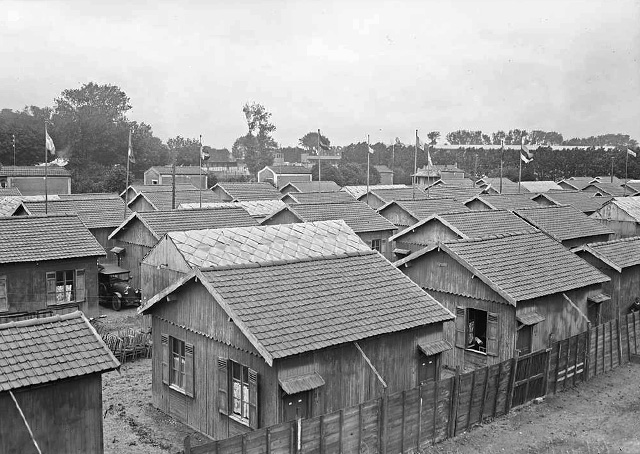 Le Village Olympique in Colombes 1924
Le Village Olympique in Colombes 1924 1928 Amsterdam
Four years later in Amsterdam, despite the success of the first village in Paris, no Olympic Village was built as organizers were not able to create something similar at a reasonable price. Instead, competitors were housed in schools and hotels, while the Americans stayed on an ocean liner moored in Amsterdam harbor, the ship they had sailed on from home.
1932 Los Angeles
The athlete village in Los Angeles in 1932 was the first to be created following a similar model to the Olympic villages of today. The village was built in the cooler climes on 300 acres in Baldwin Hills, with a view across LA. The complex consisted of a large number of buildings, athlete lodging plus many other facilities. A rate of two dollars per day was fixed for each village occupant toward the cost of his housing, dining service, local transportation, entertainment and general care.
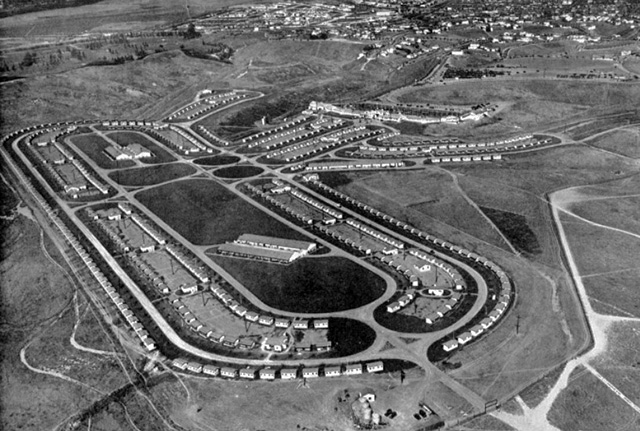 the Olympic Village in Los Angeles in 1932 (from the Olympic Games 1932 Official Report)
the Olympic Village in Los Angeles in 1932 (from the Olympic Games 1932 Official Report)With four men to a cottage, there were five hundred cottages to accommodate the two thousand athletes and their trainers and attendants. The village had its own hospital, a 2000 seat open-air amphitheater, dining rooms, post office, a full fire station, and several bath houses. As with previous Games, the women were accommodated elsewhere far away from the men, in the Chapman Park Hotel on Wilshire Boulevard. After the Games, the village was dismantled and virtually no trace survives today.
1936 Berlin
An Olympic Village (Olympisches Dorf) for men was established in woodlands at Doberlitz, about 14 kilometers from Berlin. In addition to 140 houses, the village included administrative and technical buildings, and 40 different sized dining halls to suit the different teams. There were sports facilities, as well as hairdressers and masseuses, and cultural performances and firework displays. For training, there was a swimming pool, a sports hall and a 400m running track. The building remained after the Olympics and was used mostly by the military, but is now empty and is an open-air museum which can be visited. Again, the females were accommodated separately, in student dormitories at the Olympic Park.
1948 London
Post-war, the Olympics were conducted on a budget, and no specific athlete village was constructed. Athletes were housed in locations in and around London - at air-force camps in Uxbridge and West Drayton and ex-military barracks in Richmond Park. The women were billeted in a hostel in central London. Petrol rationing was in force then so it was more practical for the rowers and canoeists, who were competing at Henley, to be lodged in nearby High Wycombe at local schools.
1952 Helsinki
In Helsinki in 1952, the Soviet athletes rejoined the Olympic Games, though instead of international harmony, the Soviets set up a rival Olympic village for Eastern Bloc countries. At their alternative village, instead of the Olympic Rings, a huge banner with a portrait of Josef Stalin was on display. The main athlete's village, built in the Käpylä district, was located 2.5km from the Olympic Stadium. The main village consisted of thirteen multi-storied apartment houses, a movie house and thirteen saunas. Meals were served to the athletes in a tent restaurant which had a capacity for 1,600 people. After the Olympics, the buildings were converted into apartments and are still inhabited today. Most of the women's teams stayed in a nursing school near the Olympic Stadium.
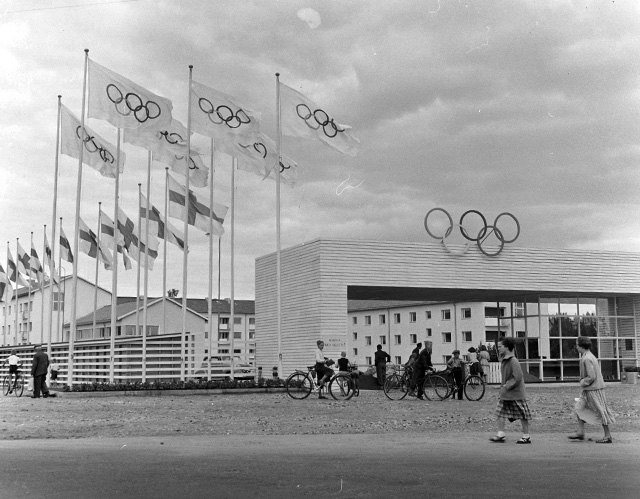 Entrance to the Olympic Village in Helsinki 1952
Entrance to the Olympic Village in Helsinki 19521956 Melbourne
Melbourne's Olympic Village in 1956 was built in the suburb of Heidelberg, 8½ miles from
the Main Stadium, set to accommodate 6,500 people. The facilities of the village included kitchens and dining rooms, recreation rooms, sauna baths,
a public coffee bar,
interpreters' center, tourist bureau,
airlines booking center,
post-office, bank, medical center and hospital, dentist, laundry, hairdressers,
boot-maker and kiosks providing free drinks.
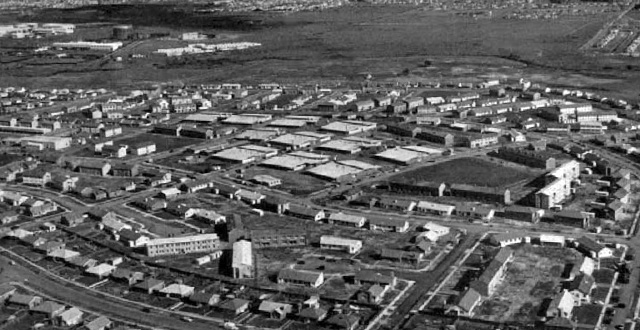 the Olympic Village in Melbourne 1956 (from the Olympic Games 1956 Official Report)
the Olympic Village in Melbourne 1956 (from the Olympic Games 1956 Official Report)For the first time, women had their own part of the main Village, but still the male athletes were not admitted into that area. After the Olympics the houses were converted to public housing.
There was a secondary village, The Ballarat Olympic Village, an existing migrant center located near Lake Wendouree for the rowing and canoeing competitors.
1960 Rome
The 1500-building Olympic Village in Rome was designed by Luigi Moretti, at the height of his influence on the city's urban plan. The village, built to accommodate 4000 people, was located in the area of the "Campo Parioli", about five kilometers from the Olympic Stadium. There were separate sections for men and women separated by a well-guarded fence. The facilities in the village included reception buildings, a movie house, lecture hall, bank and post office. There were ten restaurants for serving meals to the athletes.
1964 Tokyo
The Tokyo Olympic Village was built at a former US military housing estate, Washington Heights. New buildings were constructed for the athletes near the National Gymnasium, designed by Kenzo Tange. The facilities of the village included three dining halls (one of these in the women's Olympic Village), bank, post office, shopping center, a 700 seat motion picture theater, four bathhouses, two steam baths, a medical care station and various training facilities.
After the Olympics, the houses were torn down and the area was converted to a public park, Yoyogi Forest Green Park, in 1967. All but one house was pulled down. The house used by the Dutch Olympic team remains standing today as a 1964 Olympic Games memorial. There were also four smaller villages in the vicinity of the competition sites for the Olympic events in cycling, yachting, riding and canoeing.
1968 Mexico City
The village comprised 904 apartments distributed in 29 multi-story buildings in the Miguel Hidalgo Olympic Village Complex. The village was located in the south of the city, close to transport services, and at the most 30 minutes for all competition venues. After the Olympics, the village apartments were sold to individual families, and they still stand, well used today.
1972 Munich
The athlete village in Munich was constructed near the Olympic Stadium, and a short distance to a number of training facilities and other competition venues. The relaxed atmosphere at the Olympic village for Munich 1972 was broken by the tragic terrorists attack on the Israeli team. Ever since, security at the Olympic Village has been ramped up. The village still stands today, used as student housing. There was an additional village in Kiel where the yachting events were held, which comprised two apartment houses, thirty-two bungalows and twenty-four apartments.
1976 Montreal
Montreal's four 23-story pyramidal tower blocks to accommodate the athletes were a change to the usual Olympic villages. The construction was delayed, costs ballooned out, and the final rooms were criticized for being small. In the wake of events at the previous Olympics, the athlete village was very secure, with restricted access, and an 800 meter tunnel with direct access to the Olympic stadium. Many of the rooms remained unoccupied because of boycotts so the overcrowding was not as severe as first feared.
1980 Moscow
The 1980 Olympic village comprised eighteen 16-story prefab-panel apartment buildings, and was built in an area southwest of Moscow. It is now a residential district for about 15,000 Muscovites. There was also an athlete village constructed in Tallinn (capital of Estonia), the location of the sailing competitions.
1984 Los Angeles
Los Angeles hosted the Games for the second time in 1984. To minimize new building costs, the "village" was spread among various buildings on the USC, UCLA, and UCSB university campuses. There were discos, video games and coffee houses on offer, though no alcohol. At these Games, for the first time the athletes were accommodated by team, so the male and females athletes were not separated.
1988 Seoul
The athlete village accommodation complex, located southeast of Seoul, comprised twenty-one multiple-story buildings, home to nearly 15,000 athletes and officials from 161 countries. The facilities included a shopping center, religious center, medical center, barber shop, beauty salon, theater, pharmacy, sauna, disco, laundry room, tea room, billiard room, video-game room and a dining hall with a capacity to feed 4,200 at once. After the games, the buildings became a public housing development.
1992 Barcelona
For Barcelona in 1992, a whole new suburb was built (La Vila Olímpica). It was the first Olympic Village to have its own private beach. An entire neighborhood was built around the Olympic Village, part of the redevelopment of a two-mile stretch along the coast with beaches, parks, open space and art. The village became residential after the Games. Secondary villages were built in Banyoles and La Seu d'Urgell for rowing and white water canoeing athletes. To the delight of the team officials, it was the first to be offered free of charge to the athletes.
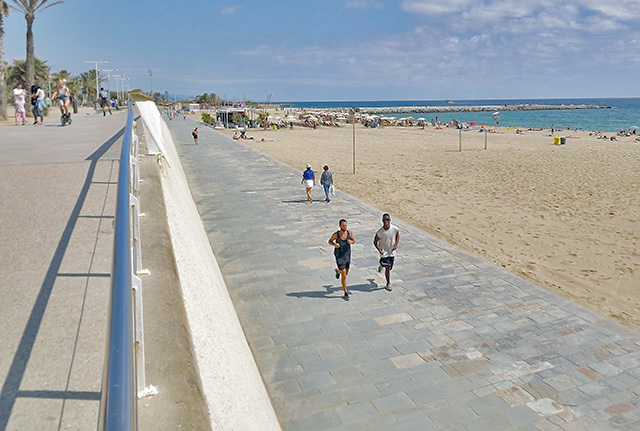 the Olympic Village beach in Barcelona
the Olympic Village beach in Barcelona 1996 Atlanta
As in the previous Olympic Games held in the USA in 1984, the Atlanta organizers used university accommodation for the athletes. The Olympic Village buildings are now dormitories at the Georgia Institute of Technology. In the International Zone, the ''Surfing Shack'' provided many athletes with their first experience with the Internet. Athletes could even have dental and hearing checkups and treatment.
2000 Sydney
The Sydney 2000 athlete village was built in Newington, two kilometers east of the Sydney Olympic Park. It provided housing for 15,300 competitors and team officials as well as accommodation for 7,500 competitors and officials for the Paralympic Games. It claimed to be the first village capable of accommodating every participant in the Games. With the large number of tenants, it became the fifth largest city in New South Wales by way of population. After the Games, the houses were sold to the public.
2004 Athens
Athens organizers created a new suburb composed of multi-story apartments in the Parnitha area, located in northeast Athens near the main Olympic complex. The Athens Olympic Village also became a residential area following the Games, and today is one of the largest social housing complexes in Greece.
2008 Beijing
The Beijing athlete village was a complex of high-rise apartments; twenty-two 6-story buildings and twenty 9-story buildings, to accommodate 16,000 athletes and officials during the Olympic Games and 7,000 athletes and officials during the Paralympic Games. The village covered a total area of 66 hectares, with the Olympic Forrest Park to its North and the major Olympic venues to its South. The village included a medical clinic, restaurants, a library, a recreation center, gyms, swimming pools, tennis courts, basketball courts and jogging tracks. There was also athlete accommodation in Hong Kong, at the Royal Park Hotel.
2012 London
The village for London 2012 was a redevelopment of a predominantly industrial area, the Lower Lea Valley, in east London. The Village was within walking distance of the Olympic park and most of the sporting venues, and comprised of 11 apartment blocks with 2,818 apartments to accommodate the 16,000 athletes and officials. Facilities included a hair salon, a mini-recording studio, a games room, a cinema room, and a dining hall which could seat up to 5,000. After the Olympics, the apartments became affordable housing.
2016 Rio de Janeiro
The village in Rio was located in Barra da Tijuca, close to next to Barra Olympic Park Sports Complex. The athletes' village which comprised thirty-one 17-floor buildings for a total of 3,604 apartments, was said to be the largest in Olympic history, with a capacity for 17,950 people. The village complex contains a large recreation area with video games, musical instruments and tables for snooker and table tennis, a beauty salon and a state-of-the-art gym. There was also a multi-faith center to cater to those of the Christian, Jewish, Islamic, Buddhist and Hindu faiths.
2021 Tokyo
The main athlete village is located in Harumi, an island district of Chūō, central Tokyo. The Harumi Futo village will have 21 residential buildings with over 5000 units. There are also two satellite villages, for cycling and sailing. Due to coronavirus, visiting athletes will be expected to arrive in the Tokyo 2020 Athletes' Village five days prior to their competition and depart a maximum of two days afterwards. Athletes residing in satellite villages who have completed their competition are not recommended to return to reside in the Tokyo Olympic Village in order to minimize the risk of cross-contamination. Athletes are also likely to be told to remain in the Village and will be encouraged not to go out sightseeing.
2024 France
The athlete's village for the Paris 2024 will be located 7 km north of the Paris central business district in the communes of Saint-Denis, L'Île-Saint-Denis and Saint-Ouen-sur-Seine, with many areas along the banks of the Seine river. The compact village will be conveniently located, with all athletes able to train at a venue less than 20 minutes away, and 85% of the athletes will be less than 30 minutes away from their competition venue. The main stadium is less than 5 minutes away.
2028 Los Angeles
As in the previous Olympic Games in Los Angeles, organizers do not plan to build an Olympic Village. The athletes will live in student housing at the University of California, Los Angeles (UCLA), which was already planning to build more dorms. The school is expected to easily house 17,000 people by 2028.
Resources
- https://www.insidethegames.biz/articles/1038893/a-history-of-athletes-villages-at-an-olympic-games-from-1924-to-2016
- https://placesjournal.org/article/olympic-urbanism-the-athletes-village/
- https://en.wikipedia.org/wiki/Olympic_Village
- Olympic Summer Games Villages from Paris 1924 to Rio 2016. OSC REFERENCE COLLECTION, The Olympic Studies Centre. Jan 2018.
Related Pages
- Winer Olympics Athlete Villages
- Olympic Games main stadiums
- Olympic Village Dining Halls and food provision
- Olympic Games host countries


 Current Events
Current Events